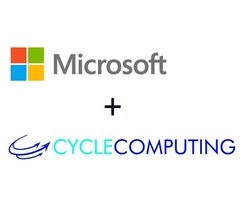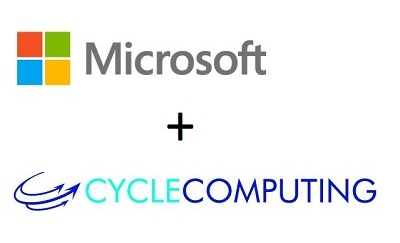
Aug. 16, 2017
By: Michael Feldman
 Microsoft has bought Cycle Computing, an established provider of cloud orchestration tools for high performance computing users. The acquisition offers the prospect of tighter integration between Microsoft Azure’s infrastructure and Cycle’s software, but suggests an uncertain future for the technology on Amazon Web Services (AWS) and Google’s cloud platform.
Microsoft has bought Cycle Computing, an established provider of cloud orchestration tools for high performance computing users. The acquisition offers the prospect of tighter integration between Microsoft Azure’s infrastructure and Cycle’s software, but suggests an uncertain future for the technology on Amazon Web Services (AWS) and Google’s cloud platform.
In a blog posted by Cycle Computing CEO and co-founder Jason Stowe, he noted the advantages of Azure’s scale and market position, writing:
Its global cloud footprint and unique hybrid offering is built with enterprises in mind, and its Big Compute/HPC team has already delivered pivotal technologies such as InfiniBand and next generation GPUs. The Cycle team can’t wait to combine CycleCloud’s technology for managing Linux and Windows compute & data workloads, with Microsoft Azure’s Big Compute infrastructure roadmap and global market reach.
Cycle Computing was founded by in 2005, without the benefit of venture capital or large investors. According to Stowe, the company was bootstrapped using $8,000 charged against a credit card. That was apparently enough to launch CycleCloud, a software suite that provides cluster provisioning, configuration, monitoring, and optimization. Today, CycleCloud is used to manage a billion core-hours of cloud computing, primarily on infrastructure provided by AWS, Google, and Microsoft Azure, as well as on in-house clusters. Stowe claims the business, measured in core-hours, is growing 2.7x per year.
CycleCloud is applicable to essentially any HPC domain, but it most prevalent in the areas of biotech/pharma, manufacturing, financial services, digital content creation, and scientific research. Cycle made a name for itself by orchestrating some of the largest on-demand clusters ever attempted. A record run on 156,000 cores, using EC2 spot instances with AWS, was used to evaluate 220,000 candidate compounds for building better solar cells. That work was done by researchers at the University of Southern California (USC). Besides UCS, other marquee customers with big cloud jobs are Novartis, Pacific Life, Johnson & Johnson, HGST, and the Broad Institute.
Microsoft, of course, is no stranger to big customers with equally big demands. Azure already supports HPC-type workloads, but not in the shrink-wrapped way that the Cycle platform does. In fact, CycleCloud uses the low-level API hooks on cloud platforms like Azure to provision the hardware and configure the software stack for the user. It also monitors the executing job to dynamically optimize allocation and use of resources. Any of this can be accomplished on bare Azure; it just requires more programming effort.
Since CycleCloud already supports Azure, what does Microsoft get out of this? In a separate blog penned by Jason Zander, Corporate Vice President, Microsoft Azure, he says the combo of the Azure infrastructure and the Cycle technology will “open up many new possibilities.”
One of those possibilities is better Linux support. It should be noted that Azure already supports Linux containers, but apparently Zander thinks Cycle can help further this capability. It’s no mystery why Microsoft would consider this important, inasmuch as Linux applications are taking a growing share of Azure jobs. A ZDNet article from last year reported that “Microsoft has gone from one in four of its Azure virtual machines running Linux to nearly one in three.” For its part, CycleCloud supports both Linux and Windows, but the vast majority of HPC customers are devoted to Linux, something Microsoft came to grips with several years ago when it was peddling its Windows HPC Server OS.
Another potential advantage to bringing Cycle in-house is offering better support for some of the fastest growing application domains in the cloud, namely artificial intelligence, the internet of things, and deep learning. Here Zander points to Cycle Computing’s “depth and expertise in massively scalable applications.” Especially in the AI arena, CycleCloud could provide a convenient orchestration of Azure’s GPU instances and FPGA-powered servers. Combined that with Azure’s Cognitive Services, and you have the makings of a formidable AI platform.
While all of that paints an interesting portrait of CycleCloud and Azure, current customers on AWS and Google will likely find themselves left out of the picture. When asked to provide some detail on what will become of the Cycle support for other cloud providers, Microsoft offered this:
“We will continue to support Cycle Computing clients using AWS and/or Google Cloud. Future Microsoft versions released will be Azure focused. We are committed to providing customers a seamless migration experience to Azure if and when they choose to migrate.”
Which is another way of saying if you want to remain a CycleCloud customer going forward, you’re going to end up on Azure. Using the prospect of future Cycle support to encourage such migration could be an unstated motivation for buying the company. Microsoft is locked in a battle with both Google and Amazon for cloud computing dominance, with Amazon currently the clear leader. Any leverage that Microsoft can used to peel off customers from its rivals, especially customers needing massive amounts of servers, works to its advantage. And by that criteria alone, the Cycle Computing acquisition looks like a wise move.
